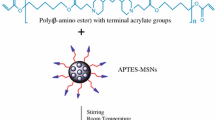Abstract
The use of nanotechnology in drug delivery is a rapidly expanding field. Biodegradable or nontoxic nanomaterials have the most promising application potentials in nanomedicine. Herein, we report a novel core-shell nanoparticle with double shell coatings (silica and poly(D,L-lactide-co-glycolide) (PLGA)) with the total shell thickness of (8.7 ± 1.3) nm. The outer shell of PLGA is biodegradable and used for controlled and sustained release, and the inner shell of silica is mesoporous for the preservation of the chemical radiation therapeutic of methyl viologen (MV), an oxidant that produces reactive oxygen species during cancer radiation therapy. The dissolution time course data and transmission electron microscopy images showed that the novel nanoparticles (Au@SiO2&PLGA) have been successfully prepared, and silica and PLGA coated well the gold (Au) template surfaces. Nanocapsules (MV@SiO2&PLGA) were obtained after the gold templates were dissolved using sodium cyanide. The sustained release property was characterized through detecting fluorescence quenching time course of fluorescent isothiocyanate after mixing with MV@SiO2&PLGA nanocapsules that encapsulate MV molecules. The sustained release of MV molecules could be extended to approximately four weeks. This novel delivery system has high potential in future application for the delivery of therapeutic drugs, particularly for the treatment of cancer by radiation therapy.
Similar content being viewed by others
References
Panyam J, Labhasetwar V. Biodegradable nanoparticles for drug and gene delivery to cells and tissue. Adv Drug Deliv Rev, 2003, 55: 329–347
Cegnar M, Premzl A, Zavasnik-Bergant V, et al. Poly(lactide-coglycolide) nanoparticles as a carrier system for delivering cysteine protease inhibitor cystatin into tumor cells. Exp Cell Res, 2004, 301: 223–231
Farokhzad O C, Cheng J, Teply B A, et al. Targeted nanoparticle- aptamer bioconjugates for cancer chemotherapy in vivo. Proc Natl Acad Sci USA, 2006, 103: 6315–6320
Cheng J, Teply B A, Sherifi I, et al. Formulation of functionalized PLGA-PEG nanoparticles for in vivo targeted drug delivery. Biomaterials, 2007, 28: 869–876
Liu Y, Miyoshi H. Preparation and characterization of novel drug delivery system of light-sensitive silica nanocapsules with thin shells. J Biomed Nanotechnol, 2008, 4: 25–32
Luo D, Han E, Belcheva N, et al. A self-assembled, modular DNA delivery system mediated by silica nanoparticles J Control Release, 2004, 95: 333–341
Bharali D J, Klejbor I, Stachowiak E K, et al. Organically modified silica nanoparticles: a nonoviral vector for in vivo gene delivery and expression in the brain. Proc Natl Acad Sci USA, 2005, 102: 11539–11544
Lim H J, Nam H Y, Lee B H, et al. A novel technique for loading of paclitaxel-PLGA nanoparticles onto ePTFE vascular grafts. Biotechnol Prog, 2007, 23: 693–697
Esmaeili F, Ghahremani M H, Ostad S N, et al. Folate-receptor-targeted delivery of docetaxel nanoparticles prepared by PLGA-PEG-folate conjugate. J Drug Target, 2008, 16: 415–423
Anglin E J, Chen L, Freeman W R, et al. Porous silicon in drug delivery devices and materials. Adv Drug Deliv Rev, 2008, 60: 1266–1277
Liu Y, Miyoshi H, Nakamura M. Novel drug delivery system of hollow mesoporous silica nanocapsules with thin shells: preparation and fluorescein isothiocyanate (FITC) release kinetics. Colloids Surf B Biointerfaces, 2007, 58: 180–187
Lai C Y, Trewyn B G., Jeftinija D M, et al. A mesoporous silica nanosphere-based carrier system with chemically removable CdS nanoparticle caps for stimuli-responsive controlled release of neurotransmitters and drug molecules. J Am Chem Soc, 2003, 125: 4451–4459
Giri S, Trewyn B G, Stellmaker M P, et al. Stimuli-responsive controlled-release delivery system based on mesoporous silica nanorods capped with magnetic nanoparticles. Angew Chem Int Ed Engl, 2005, 44: 5038–5044
Meahcov L, Sandu I. Colloidal CdS fluorescence quenching by MV2+ under continuous irradiation. J Fluoresc, 2004, 14: 181–185
Liz-Marzan L M, Giersig M, Mulvaney P. Synthesis of nanosized gold-silica core-shell particles. Langmuir, 1996, 12: 4329–4335
Nie H, Wang C H. Fabrication and characterization of PLGA/HAp composite scaffolds for delivery of BMP-2 plasmid DNA. J Control Release, 2007, 120: 111–121
Author information
Authors and Affiliations
Corresponding author
About this article
Cite this article
Yang, H., Miyoshi, H., Lou, C. et al. Preparation, characterization and release of methyl viologen from a novel nanoparticle delivery system with double shells of silica and PLGA. Chin. Sci. Bull. 55, 263–267 (2010). https://doi.org/10.1007/s11434-009-0561-0
Received:
Accepted:
Published:
Issue Date:
DOI: https://doi.org/10.1007/s11434-009-0561-0




